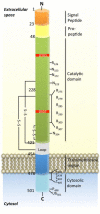The normal and pathologic roles of the Alzheimer's β-secretase, BACE1
- PMID: 24893886
- PMCID: PMC4401991
- DOI: 10.2174/1567205011666140604122059
The normal and pathologic roles of the Alzheimer's β-secretase, BACE1
Abstract
As the most common neurodegenerative disease, therapeutic avenues for the treatment and prevention of Alzheimer's Disease are highly sought after. The aspartic protease BACE1 is the initiator enzyme for the formation of Aβ, a major constituent of amyloid plaques that represent one of the hallmark pathological features of this disorder. Thus, targeting BACE1 for disease-modifying AD therapies represents a rationale approach. The collective knowledge acquired from investigations of BACE1 deletion mutants and characterization of BACE1 substrates has downstream significance not only for the discovery of AD drug therapies but also for predicting side effects of BACE1 inhibition. Here we discuss the identification and validation of BACE1 as the β-secretase implicated in AD, in addition to information regarding BACE1 cell biology, localization, substrates and potential physiological functions derived from BACE1 knockout models.
Figures

References
-
- Citron M, Teplow DB, Selkoe DJ. Generation of amyloid beta protein from its precursor is sequence specific. Neuron. 1995;14(3):661–70. - PubMed
-
- Hussain I, Powell D, Howlett DR, Tew DG, Meek TD, Chapman C, et al. Identification of a novel aspartic protease (Asp 2) as beta-secretase. Mol Cell Neurosci. 1999;14(6):419–27. - PubMed
Publication types
MeSH terms
Substances
Grants and funding
LinkOut - more resources
Full Text Sources
Other Literature Sources
Medical
Molecular Biology Databases
Research Materials

